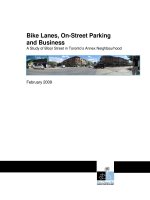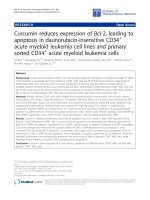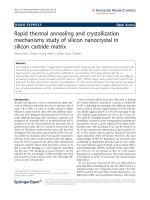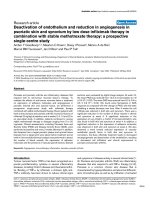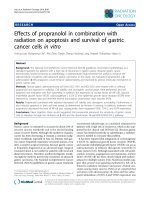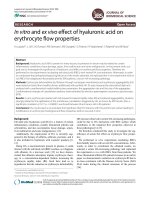In vitro and in vivo study of ABT 869 in treatment acute myeloid leukemia (AML) alone or in combination with chemotherapy or HDAC inhibitors insight into molecular mechanism and biologic characterization
Bạn đang xem bản rút gọn của tài liệu. Xem và tải ngay bản đầy đủ của tài liệu tại đây (2.98 MB, 121 trang )
Molecular and Biological Studies of Novel Treatment
for Acute Myeloid Leukemia
Zhou Jianbiao
National University of Singapore
2009
In vitro and In vivo study of ABT-869 in treatment
acute myeloid leukemia (AML) alone or in
combination with chemotherapy or HDAC inhibitors:
insight into molecular mechanism and biologic
characterization
Zhou Jianbiao
(M.D. Nanjing, M.sc. National University of Singapore)
A THESIS SUBMITTED
FOR THE DEGREE OF DORCTOR OF PHILOSOPHY
DEPARTMENT OF MEDICINE
YONG LOO LIN SCHOOL OF MEDICINE
NATIONAL UNIVERSITY OF SINGAPORE
Singapore 2009
I
ACKNOWLEDGEMENTS
I would like to express my thanks from my bottom of heart to the following for their
support, encouragement, contribution, and help to my study and thesis:
First of all to my supervisor, Dr. Chen Chien-Shing, whom I first worked with when I
came back from Boston, USA and for giving your support. I am grateful to the flexible
and stimulating work environment you created.
Dr. Hanry Yu, my co-supervisor for your gracious commitments, for supporting my
works, especially in the period of transition time in the lab.
Dr. Chng Wee-Joo with your striking passion in cancer research. Thank you for
providing me the advice and the opportunity to work with you.
My Ph.D. qualified examination committee-Drs Fred Wong, Goh Boon-Cher, Shazib
Pervaiz for the excellent suggestions.
Bi Chonglei for giving me great helps in the works on this thesis.
All present and former colleagues in Drs Chen’s and Dr Chng’s labs, especially
Janaka V. Jasinghe, Pan Mengfei, Liu Shaw-Cheng, Tay Kian Ghee Xie Zhigang,
Poon Lai-Fong, Alexis Khng for their helps.
Lim Bee-Choo and Evelyn Neo for their excellent administrative support.
Keith B. Glaser, Daniel H. Albert, Steven K. Davidsen in Abbott Labtoratories for
providing ABT-869.
My daughter Nina who is always at the center of my heart and my wife and soul mate
Liqin for encouraging me and doing most of housework.
These studies were made possible by Singapore Cancer Syndicate, A*Star,
Singapore as well as, Singapore Cancer Society through the Terry Fox Run Fund.
II
TABLE OF CONTENTS
Acknowledgements I
Table of Contents II
Publications derived from this thesis V
Other publications during study period VI
Summary VII
List of Tables IX
List of Figures X
List of abbreviations XII
Chapter 1. Synergistic antileukemic effects between ABT-869 and
chemotherapy involve downregulation of cell cycle regulated genes
and c-Mos-mediated MAPK pathway 1
1.1. Introduction 2
1.2. Materials and method 3
1.2.1. Cell lines and primary patient samples 3
1.2.2. ABT-869 and chemotherapy reagents 4
1.2.3. Cell viability assays 4
1.2.4. Combination index and isobologram analysis 5
1.2.5. Immunoblot analysis 6
1.2.6. Low density Array (LDA) 6
1.2.7. Short-hairpin (sh) RNA studies 7
1.2.8. Xenograft mouse model 8
1.2.9. Immunohistochemistry (IHC) 9
1.2.10. Statistical analysis 10
1.3. Results 10
1.3.1. Molecular signaling pathways of cell cycle arrest and
apoptosis induced by ABT-869 treatment 10
1.3.2. Simultaneous treatment with ABT-869 and
chemotherapeutic agents 11
1.3.3. Sequence-dependent interactions between ABT-869 and
chemotherapy 12
1.3.4. Inhibition of cell cycle related genes and MAPK pathway
played an important role in the synergistic mechanism 15
1.3.5. In vivo efficacy of ABT-869, alone or in combination with
cytotoxic drugs, for treatment in MV4-11 mice xenografts 18
1.3.6. Molecular events following in vivo treatment of MV4-11
tumors with ABT-869 19
1.4. Discussion 19
1.5. References 23
Chapter 2. In vivo activity of ABT-869, a multi-target kinase inhibitor, against
acute myeloid leukemia with wild-type FLT3 receptor 26
III
2.1. Introduction 26
2.2. Materials and methods 28
2.2.1. Cell culture and establishment of a fluorescent protein
labeled leukemia cell line 28
2.2.2. Drug preparation 28
2.2.3. Xenograft leukemia models 29
2.2.3.1. Subcutaneous model 30
2.2.3.2. Bone marrow transplantation model 30
2.2.4. Visualization of treatment efficacy in living mice 31
2.2.5. Cell staining, antibodies, and flow cytometry 32
2.2.6. Immunohistochemistry (IHC) 32
2.2.7. TUNEL assay
2.2.8. Statistical analysis 32
2.3. Results 32
2.3.1. Establishment of stable HL60-RFP cell line 32
2.3.2. ABT-869 inhibited the HL60-RFP xenograft tumor progression
33
2.3.3. ABT-869 prolonged survival in the HL60-RFP murine bone
marrow transplantation model 37
2.3.4. In vivo biological efficacy of ABT-869 39
2.4. Discussion 41
2.5. References 44
Chapter 3. Enhanced activation of STAT pathways and overexpression of
survivin confer resistance to FLT3 inhibitors and could be therapeutic targets
in AML 47
3.1. Introduction 47
3.2. Materials and Methods 48
3.2.1. Small molecular inhibitors and reagents 49
3.2.2. Cell lines and development of resistant cell lines 49
3.2.3. Cell viability assays 49
3.2.4. Flow cytometric analysis 50
3.2.5. Western blot analysis 50
3.2.6. Low density Array (LDA) 50
3.2.7. Reverse transcription (RT)-PCR and Real-time
quantitative (RQ)-PCR 51
3.2.8. Transfection 51
3.2.9. Short-hairpin (shRNA) studies
3.2.10. Chromatin immunoprecipitation (ChIP) assay 52
3.2.11. Xenograft mouse model 53
3.2.12. Immunohistochemistry (IHC) 53
3.2.13. Statistical analysis 54
3. 3. Results 55
3.3.1. Long term coculture of MV4-11 cells with ABT-869 resulted
in cross-resistance to other FLT3 inhibitors 55
3.3.2. Overexpression of FLT3, p-FLT3 receptor or multi-drug
resistant related proteins or mutations in KD were not
responsible for resistance to FLT3 inhibitors in MV4-11-R 56
3.3.3. Identification of enhanced activation of STAT pathways
and overexpression of survivin in the resistant lines 58
3.3.4. Upregulation of survivin in MV4-11-R cells resulted in changes
IV
in cell cycle and apoptosis 62
3.3.5. FLT3 ligand mediated STAT activities and survivin expression
62
3.3.6. Modulation of survivin expression influenced drug sensitivity 64
3.3.7. Indirubin derivative (IDR) E804 induced apoptosis through
inhibition of STAT pathway and survivin and sensitized
MV4-11-R to ABT-869 66
3.3.8. Survivin was a direct target of STAT3
3.3.9. In vivo efficacy of IDR E804 in combination with ABT-869
for treatment of MV4-11-R mouse xenografts 69
3.4. Discussion 73
3.5. References 78
Chapter 4. The combination of HDAC Inhibitors and a FLT-3 inhibitor, ABT-
869, induce lethality in acute myeloid leukemia cells with FLT3-ITD
synergistically through PRL-3 downregulation 82
4.1. Introduction
4.2. Materials and Methods 84
4.2.1. Cell lines and primary patient samples 84
4.2.2. Drugs and chemicals 84
4.2.3. Cell proliferation assays 84
4.2.4. Human Stromal cell coculture system 85
4.2.5. Combination index calculation 85
4.2.6. Apoptosis assay 85
4.2.7. Western blot analysis 86
4.2.8. Microarray study 86
4.2.9. Real-time quantitative (RQ)-PCR 87
4.2.10. Construction and infection of PRL-3-expression vector 88
4.3. Results 88
4.3.1. Synergistic cytotoxicity of combination of ABT-869 and
SAHA in leukemia 88
4.3.2. Effect of ABT-869 plus SAHA on resistant MV4-11 cells
and stromal cell coculture system 92
4.3.3. Identifying core gene signature crucial for the synergism
between ABT-869 and SAHA 93
4.3.4. PRL-3 protected cells from apoptosis induced by ABT-869,
SAHA alone or the combination therapy 97
4.3.5. Targeting PRL-3 enhanced ABT-869-mediated cytotoxicity to
MV4-11 and MOLM-14 98
4.4. Discussion 100
4.5. References 103
V
PUBLICATIONS DERIVED FROM THIS THESIS
1. Zhou J, Pan M, Xie Z, Loh SL, Bi C, Tai YC, Lilly M, Lim YP, Han JH, Glaser KB,
Albert DH, Davidsen SK, Chen CS. Synergistic antileukemic effects between ABT-
869 and chemotherapy involve downregulation of cell cycle regulated genes and c-
Mos-mediated MAPK pathway. Leukemia. 2008; 22(1): 138-146.
2. Zhou J, Khng J, Jasinghe VJ, Bi C, Neo CH, Pan M, Poon LF, Xie Z, Yu H, Yeoh
AE, Lu Y, Glaser KB, Albert DH, Davidsen SK, Chen CS. In vivo activity of ABT-
869, a multi-target kinase inhibitor, against acute myeloid leukemia with wild-type
FLT3 receptor. Leukemia Research. 2008; 32(7): 1091-100.
3. Zhou J, Bi C, Jasinghe VJ, Liu SC, Tan KG, Poon LF, Xie Z, Palaniyandi S, Chng
WJ, Yu H, Glaser KB, Albert DH, Davidsen SK, Chen CS. Enhanced activation of
STAT pathways and overexpression of survivin confer resistance to FLT3 inhibitors
and could be therapeutic targets in AML. Blood. 2009;113(17):4052-62.
4. Zhou J, Bi C, Chng WJ, Liu SC, Tan KG, Xie Z, Yu H, Glaser KB, Albert DH,
Davidsen SK, Chen CS. SAHA, a HDAC inhibitor, synergistically potentiates ABT-
869 lethality in acute myeloid leukemia cells with FLT3-ITD mutation in association
with PRL-3 downregulation. Under Review.
5. Zhou J, Goh BC, Albert DH, Chen CS. ABT-869, a promising multi-targeted
tyrosine kinase inhibitor: from bench to bedside. J Hematol Oncol. 2009 Jul 30;2:33.
.
VI
OTHER PUBLICATIONS DURING STUDY PERIOD
1. Zhou J, Goldwasser MA, Li A, Dahlberg SE, Neuberg D, Wang H, Dalton V,
McBride KD, Sallan SE, Silverman LB, Gribben JG. Quantitative analysis of minimal
residual disease predicts relapse in children with B-lineage acute lymphoblastic
leukemia in DFCI ALL consortium protocol 95-01. Blood. 2007;110(5):1607-11.
2. Shen J, Tai YC, Zhou J, Stephen Wong CH, Cheang PT, Fred Wong WS, Xie Z,
Khan M, Han JH, Chen CS. Synergistic antileukemia effect of genistein and
chemotherapy in mouse xenograft model and potential mechanism through MAPK
signaling. Experimental Hematology. 2007;35(1):75-83.
3. Xie Z, Choong PF, Poon LF, Zhou J, Khng J, Jasinghe VJ, Palaniyandi S, Chen
CS. Inhibition of CD44 expression in hepatocellular carcinoma cells enhances
apoptosis, chemosensitivity, and reduces tumorigenesis and invasion. Cancer
Chemotherapy Pharmacology. 2008;62(6):949-57.
4. Jasinghe VJ, Xie Z, Zhou J, Khng J, Poon LF , Senthilnathana P, Glaser KB,
Albert DH, Davidsen SK, Chen CS. ABT-869, a multi-targeted tyrosine kinase
inhibitor, in combination with rapamycin is effective for hepatocellular carcinoma
(HCC) in vivo.
Journal of Hepatology. 2008;49(6):985-97.
5. Xie Z, Chng WJ, Tay KG, Liu SC, Zhou J, Chen CS. Therapeutic potential of
antisense oligodeoxynucleotides to down-regulate p53 oncogenic mutations in
cancers. Under review
VII
SUMMARY
The fate of adult leukemia still remains dismal with 5-year disease free survival
(DFS) 2-37% for acute myeloid leukemia (AML). The current treatment approach for
AML is chemotherapy, which damages normal cells too and cause severe side
effect. The focus of this thesis has been to develop novel therapeutic strategies
targeting genetic and epigenetic abnormalities of AML or combination synergies by
dissecting the molecular pathways, thus improving clinical outcome of patients with
AML.
Internal tandem duplications (ITDs) of fms-like tyrosine kinase 3 (FLT3) receptor play
an important role in the pathogenesis of AML and represent an attractive therapeutic
target. We first demonstrate ABT-869, a multi-targeted receptor tyrosine kinase
inhibitor (TKI) as a potent FLT3 inhibitor. ABT-869 demonstrates significant
sequence dependent synergism with cytarabine and doxorubicin. Low density array
(LDA) analysis revealed the synergistic interaction involved in down-regulation of cell
cycle and MAPK pathway genes. These findings suggest specific pathway genes
were further targeted by adding chemotherapy and support the rationale of
combination therapy. Thus a clinical trial using sequence-dependent combination
therapy with ABT-869 in AML is initiated.
Neoangiogenesis plays an important role in leukemogenesis. We investigated the in
vivo anti-leukemic effect of ABT-869 against AML with wild-type FLT3 using red
fluorescence protein (RFP) transfected HL60 cells with in vivo imaging technology in
mouse xenograft models. ABT-869 showed a five fold inhibition of tumor growth and
decreased p-VEGFR1, Ki-67 labeling index, VEGF and remarkably increased
VIII
apoptotic cells in the xenograft models compared to vehicle controls. ABT-869 also
reduced the leukemia burden and prolonged survival. Our study supports the
rationale for clinically testing an anti-angiogenesis agent in AML with wild type FLT3.
we developed three isogenic resistant cell lines to FLT3 inhibitors. Gene profiling
reveals up-regulation of FLT3LG and Survivin, but down-regulation of SOCS genes
in MV4-11-R cells. Targeting survivin by shRNA induce apoptosis and augments
ABT-869-mediated cytotoxicity. Sub-toxic dose of indirubin derivative (IDR) E804
resensitize MV4-11-R to ABT-869 treatment in vitro and in vivo. Taken together,
these results demonstrate that enhanced activation of STAT pathways and
overexpression of survivin are the main mechanism of resistance to ABT-869,
suggesting potential targets for reducing resistance developed in patients receiving
FLT3 inhibitors. Our findings may indicate a common resistant mechanism in novel
therapeutic era.
So far, the FLT3 inhibitors as single agent in clinical trials only induce transient and
mild response. Small molecule HDAC inhibitors (HDACi) have proven to be a
promising new class of anticancer drugs. We demonstrated that combining ABT-869
with SAHA leaded to synergistic killing of AML cells with FLT3 mutations. To study
the molecular mechanism of their interaction, we identified a core gene signature
differentially induced more than two-fold by combination therapy in both cell lines.
Modulation of PRL-3 expression level using genetic approaches or PRL-3 inhibitor,
Pentamidine, demonstrated that PRL-3 played an essential role in the synergism
ascribing from the combination with ABT-869 and SAHA. Our results suggest such
combination therapies may significantly improve the therapeutic efficacy of FLT3
inhibitors in clinic.
IX
LIST OF TABLES
Table No. Description (Pages)
Table 1.1. Combination index (CI) values in three models of ABT-869 and
chemotherapeutic agents. 14
Table 1.2. LDA analysis revealed that combination therapy further down-regulated
genes involved in cell cycle regulation and MAPK pathway. 16
Table 3.1. Comparison the potency (IC
50
values) of ABT-869 and other structurally
unrelated FLT3 inhibitors for inhibiting the proliferation of MV4-11, MV4-11-R, MV4-
11+FLT3 ligand and MV4-11-Survivin cells. 56
Table 3. 2. Differentially expressed genes in MV4-11-R vs MV4-11. 58
Table 4.1. The sequences of primers used in real-time PCR. 87
Table 4.2. The list of core gene signature identified by Affymetrix microarray studies
of MV4-11 and MOLM-14 cells treated with combination of ABT-869 and SAHA.
95
X
LIST OF FIGURES
Figure No. Description (Pages)
Figure 1.1. ABT-869 showed different effects on a spectrum of AML cell lines. 9
Figure 1.2. ABT-869 induced G0/G1 cell cycle arrest and apoptosis of MV4-11 and
MOLM-14 cells. 10
Figure 1.3. The molecular mechanisms of cycle arrest and apoptosis induced by
ABT-869 treatment in MV4-11 and MOLM-14 cells. 11
Figure 1.4. Conservative isobolograms showing the interactions among three
different models of combination with ABT-869 and chemotherapeutic agents on the
proliferation of MV4-11 and MOLM-14 cells. 14
Figure 1. 5. CCND1 and c-Mos played important roles in the molecular mechanisms
of synergistic effect by combination therapy. 17
Figure 1.6. Combination therapy achieved a faster reduction of established tumor
volume than ABT-869 single agent or Ara-C treatment. 18
Figure 1.7. In vivo effect of ABT-869 on MV4-11 tumor xenograft model. 20
Figure 2.1. Stable human leukemia HL60 clone with high expression of RFP in vitro.
33
Figure 2.2. The effects of ABT-869 on HL60-RFP tumor growth in vivo. 35
Figure 2.3. Sequential real-time whole-body fluorescence imaging of HL60-RFP
tumor growth in living mice. 36
Figure 2.4. The effects of ABT-869 on NOD/SCID mice with systemic leukemia. 38
Figure 2.5. In vivo effect of ABT-869 on HL60-RFP tumor xenograft model. 40
Figure 2.6. ABT-869 treatment induced apoptosis in the in vivo tumor samples. 41
Figure 3.1. Comparison of the expression of phosphorylated FLT3 receptor, total
FLT3 receptor and multi-drug resistant related proteins (LRP, MRP1 and MDR)
among the parental MV-11 and resistant lines. R1, R2 and R3 induicate MV4-11-R1,
MV4-11-R2 and MV4-11-R3 respectively. 57
Figure 3.2. Validation of FLT3LG, survivin and SOCS1 and SOCS2 expression and
STAT pathway overactivation at the translational level, RQ-PCR quantification of
SOCS gene family and confirmation of normal transcript of Survivin in MV4-11-R
cells. 61
Figure 3.3. The effect of FLT3LG on activity of STAT signaling pathway and the
expression of survivin. 64
XI
Figure 3.4. Knockdown of Survivin potentiated ABT-869 induced apoptosis in MV4-
11-R cells. 66
Figure 3.5. IDR E804 induced apoptosis and sensitized MV4-11-R to ABT-869. 68
Figure 3.6. In vivo effect of combination therapy on the MV4-11-R tumor xenograft
model. 72
Figure 3.7. A model of enhanced STAT activation and overexpression of survivin
leading to resistant phenotype in MV4-11-R cells. 78
Figure 4.1. Antileukemic effect of combination of ABT-869 with SAHA or VPA on
leukemia cell lines with FLT3-ITD mutations. 89
Figure 4.2. Western blot analysis of acetylation of H3, H4 and expression of p21,
cleaved PARP in MV4-11 and MOLM-14 cells. 91
Figure 4.3. Effects of ABT-869 plus SAHA on stromal mediated resistance of MV4-11
and MOLM-14 cells. 92
Figure 4.4. Real-time quantitative-PCR validation of some gene changes in the core
gene signature identified by microarray studies. 94
Figure 4.5. Metacore network analysis of core gene signature which is common in
combination treatment in both MV4-11 and MOLM-14 cells. 95
Figure 4.6. The effect of overexpression of PRL-3 in MV4-11 cells. 96
Figure 4.7. Pentamidine potentiating ABT-869-mediated cytotoxicity on MV4-11 and
MOLM-14 cells. 98
Figure 4.8. Comparison of PRL-3 expression between FLT3-ITD negative (Class 1)
and FLT3-ITD positive (Class 2) AML patients. 99
XII
LIST OF ABBREVIATIONS
17-AAG 17-allylamino- 17-demethoxygeldanamycin
acetyl-CoA acetyl-coenzyme A
ACAT2 Acetyl-CoA Acetyltransferase 2
AML Acute Myeloid Leukemia
Ara-C Cytosine Arabinoside
BM Bone Marrow
BSA Bovine Serum
Albumin
CDK Cyclin-Dependent Kinase
C/EBPα CCAAT/enhancer-binding protein α
ChIP Chromatin Immunoprecipitation
CI Combination Index
CML Chronic Myelogenous Leukemia
CRC Colorectal Carcinomas
Csk C-terminal Src Kinase
DAPI 4'-6-Diamidino-2-phenylindole
DFS Disease Free Survival
DMSO Dimethyl Sulfoxide
Dox Doxorubicin
E2F1 E2F Transcription Factor 1
FBS Fetal Bovine Serum
FLT3 FMS-Like Tyrosine Kinase 3
FLT3LG FLT3 Ligand
G-CSF Granulocyte Colony-Stimulating Factor
GM-CSF Granulocyte Macrophage-CSF
HAT Histone Acetyltransferase
HDAC Histone Deacetylases
HPF High Power Field
HSC Hematopoietic Stem Cell
HSP90 Heat Shock Protein 90
IDR Indirubin Derivative
IFI16 Interferon gamma-inducible gene 16
IHC Immunohistochemistry
IP Intraperitoneally
ITD Internal Tandem Duplication
JNK c-Jun N-terminal Kinase
KDR Kinase Insert Domain Receptor
LDA Low density Array
LRP Lung-Resistance Protein
MAPK Aitogen-Activated Protein Kinase
MDS Myelodysplastic Syndromes
MDR Multi-Drug Resistance Protein
MM Multiple Myeloma
MVD Microvessel Density
NOD/SCID Non-diabetics/Severe Combined Immunodeficiency
OD Optical Density
ORC Origin Recognition Complex
ORC1L ORC, subunit 1-like (yeast)
PBS Phosphate Buffered Saline
XIII
PCR Polymerase Chain Reaction
PDGFR Platelet-Derived Growth Factor Receptor
PFA Paraformaldehyde
PI Propidium Iodide
PI3K Phosphoinositide 3-kinase
PLZF Promyelocytic Leukemia Zinc Finger protein
PRL-3 Phosphatase of Regenerating Liver 3
Rb Retinoblastoma Protein
RFP Red Fluorescence Protein
RNAi RNA interference
RTK Receptor Tyrosine Kinase
SD Standard Deviation
SAHA Suberoylanilide Hydroxamic Acid
SOCS Suppressor Of Cytokine Signaling
STAT Signal Transducers and Activators of Transcription
TKI Tyrosine Kinase Inhibitor
TPO Thrombopoietin
TUNEL TdT-mediated dUTP Nick-End Labeling
VEGF Vascular Endothelial Growth Factor
VPA Valproic Acid
vWF von Willibrand Factor
1
Chapter 1. Synergistic antileukemic effects between ABT-869 and
chemotherapy involve downregulation of cell cycle regulated genes and c-
Mos-mediated MAPK pathway
1.1. Introduction
Internal tandem duplications (ITDs) of the fms-like tyrosine kinase 3 (FLT3), varying
from 3 to ≥400 base pairs in the juxtamembrane d omain, are found in 20-25% of
adult AML cases.
1-3
In addition, activating point mutations in the second kinase
domain occur in about 7% of adult AML patients.
4
FLT3 mutations therefore are the
most common genetic alteration in AML. Clinically, FLT3-ITD is associated with poor
outcome, but the prognosis of FLT3 activating point mutation remains inconclusive.
5-7
FLT3-ITD mutations trigger strong autophosphorylation of the FLT3 kinase domain,
and constitutively activate several downstream effectors such as the PI3K-AKT
pathway, RAS-MEK-MAPK pathway, and the STAT5 pathway.
8,9
FLT3-ITD mutations
also suppress transcription factors associated with myeloid differentiation and
apoptosis, including PU.1, CCAAT/enhancer-binding protein α (C/EBPα),
10
promyelocytic leukemia zinc finger (PLZF) protein,
11
RUNX1/AML1,
12
RSG2
13
and
Foxo3a.
14-16
On the other hand, FLT3-ITDs up-regulate proliferation associated
genes like PIM1.
17
Taken together, FLT3-ITDs simultaneously bring on several
hallmarks of leukemogenesis
18
by blocking myeloid differentiation, inducing signaling
for uncontrolled proliferation, and producing resistance to apoptosis.
The mainstream chemotherapy regime for AML is a combination of cytosine
arabinoside (Ara-C) and anthracyclines such as doxorubicin (Dox). Despite initial
responses to chemotherapy, most adult AML eventually relapse. Long-term disease
2
free survival is only 20-30%. Thus, the development of novel therapeutic agents that
target critical genetic aberrations holds promise for improving outcomes in patients
with AML.
ABT-869, a novel ATP-competitive tyrosine kinase inhibitor (TKI), is active against
FLT3 kinase (IC
50
= 4 nM) and other platelet-derived growth factor receptor (PDGFR)
family members, as well as vascular endothelial growth factor (VEGF) receptors (IC
50
= 4, 66 and 4 nM for KDR, PDGFRβ and CSF-1R respectively), but less active
against unrelated RTKs.
19,20
Cellular assays and tumor xenograft models
demonstrated that ABT-869 was effective in a broad range of cancers including small
cell lung carcinoma, colon carcinoma, breast carcinoma, and MV4-11 tumors in vitro
and in vivo.
19,21
However, considering the complexity of the disease, monotherapy
with ABT-869 is unlikely to deliver complete or lasting responses in AML.
Furthermore, resistance to TKIs has been well described in patients treated with
imatinib mesylate monotherapy for chronic myelogenous leukemia (CML).
22
Combination regimens including ABT-869 and conventional chemotherapy may
potentially reduce resistance and achieve better outcomes for AML patients.
A combination approach has also been pursued with other TKIs. It has been
reported that combination of SU11248 with Ara-C or Dox exerted synergistic effects
23
and CEP-701 showed in vitro sequence-dependent synergistic cytotoxic effects on
FLT3-ITD leukemia cells when combined with chemotherapy.
24
In this study, the
sequence-dependent synergism was attributed to CEP-701 induced cell cycle arrest
and it was speculated that the sequential treatment first induced pro-apoptotic
signals, then withdrew pro-survival signals.
25
Studies of the molecular mechanisms
on synergistic interactions are needed for better understanding the full potential of
3
combination therapy. The chemical structure of ABT-869 (N-[4-(3-amino-1H-indazol-
4-yl)phenyl]-N1-(2-fluoro-5-methylphenyl)
urea) is different from SU11248 (3-
Substituted indolinoneindolinone) and CEP-701 (Indolocarbazole)
19
suggesting that
the therapeutic efficacy of ABT-869 can not be extrapolated from the experience of
related compounds. Hence, the clinical applications of ABT-869 will greatly benefit
from better understanding of the molecular mechanism of the compound in sole or
combination therapies both in vitro and in vivo.
We here, for the first time, present further characterization of molecular mechanism
of G
1
-phase cell cycle arrest and apoptosis caused by ABT-869 as a single agent
and the potential mechanism of synergism with the cytotoxic agents Ara-C and Dox
in vitro and in vivo.
1. 2. Materials and methods
1.2.1. Cell lines and primary patient samples
MV4-11 and MOLM-14 cells were cultured with RPMI1640 (Invitrogen, Carlsbad, CA)
supplemented with the addition of 10% of fetal bovine serum (FBS, JRH Bioscience
Inc, Lenexa, KS) at density of 2 to 10 x 10
5
cells/ml in a humid incubator with 5%
CO
2
at 37ºC.
Bone marrow (BM) blast cells (>90%) from newly diagnosed AML patients were
obtained at National University Hospital (NUH) in Singapore with informed consent.
Three samples were confirmed to harbor a 36, 60/78 (two duplicated fragments
detected), 62 bp ITDs of FLT3 gene respectively and one had D835Y (GAT -> TAT
at codon 835) point mutation. Thawed cells were cultured in EGM™-2 medium
(Cambrex, Walkersville, MD) supplemented with SingleQuots
®
(Cambrex) growth
4
factors, cytokines (hFGF, hEGF, Hydrocortisone, GA-1000 , VEGF, R
3
-IGF-1) with
or in absence of drug incubation.
1.2.2. ABT-869 and chemotherapy reagents
ABT-869 was kindly provided by Abbott Laboratories (Chicago, IL). For in vitro and in
vivo experiments, ABT-869 was prepared as published before.
21
Clinical grade Ara-
C (100 mg/mL, Pharmacia, WA, Australia) and Dox (2 mg/mL, Pharmacia) were
diluted just before use. The MEK inhibitor U0126 was purchased from Promega and
dissolved in DMSO at concentration of 10 mM as stock. It was further diluted before
use.
1.2.3. Cell viability assays
Leukemic cells were seeded in 96-well culture plates at a density of 2 × 10
4
viable
cells/100 µl/well in triplicates, and were treated with ABT-869, chemotherapeutic
agents or combination therapy. Colorimetric CellTiter 96 AQ
ueous
One Solution Cell
Proliferation Assay (MTS assay, Promega, Madison, WI) was used to determine the
cytotoxicity. The absorbance of each well was recorded at 490 nm using an
Ultramark® 96-well plate reader (Bio-Rad, Hercules, CA). The percentage of viable
cell was reported as the mean of optical density (OD) of the treated wells divided by
the mean of OD of DMSO control wells after normalization to the signal from wells
without cells. IC
50
was determined by MTS assay and calculated with CalcuSyn
software (Biosoft, Cambridge, UK). Each experiment was triplicated.
1.2.4. Combination index and isobologram analysis
The calculation of combination index (CI) and isobolograms with the CalcuSyn
software was described previously.
26
Briefly, the CI values were calculated
5
according to the levels of growth inhibition (Fraction affected, Fa) by each agent
individually and combination of ABT-869 with Ara-C or Dox or U0126. Isobolograms,
which indicate the equipotent combinations of different dose (ED
50,
ED
75
and ED
90
,
etc), were used to illustrate synergism (CI <1), antagonism (CI >1) and additivity (CI
= 1). Constant ratio combinations of the two drugs at 0.25x, 0.5x, 1x, 2x and 4x of
their ED
50
was used. Three independent studies were conducted for each
combination.
1.2.5. Immunoblot analysis
Preparation of the cell lysate and immunoblotting were performed as previously
described.
26
Antibodies used were as follows: anti-cyclins D and E, anti-Bcl-xL, anti-
Bcl2, anti-BAD, anti-BAX, anti-BAK, anti-poly (ADP-ribose) polymerase (PARP), anti-
cleaved PARP, anti-caspase-3, anti-cleaved caspase-3, anti-caspase-7, and anti-
cleaved caspase-7 from Cell Signaling Technology (CST, Danvers, MA); anti-Actin,
anti-p21, anti-p27, anti-p53, anti-CDK2, and anti-CDK4 from Santa Cruz
Biotechnology (Santa Cruz, CA). Rabbit anti-human c-Mos oncoprotein polyclonal
antibody was purchased from Chemicon (Temecula, CA).
1.2.6. Low density Array (LDA)
Gene expression profiling was investigated with custom PCR-based analysis using
TaqMan® Low Density Arrays (LDA; Applied Biosystems, Foster City, CA).
27
RNA
was extracted from cells using Purescript RNA isolation kit (Genetra systems,
Minneapolis, MN). First strand cDNA was synthesized with SuperScript® III First-
Strand Synthesis SuperMix (Invitrogen). PCR amplification was performed in the
7900HT Fast Real-time System (Applied Biosystems). The LDA array was custom
made with TaqMan® Gene Expression Assays, which allows the simultaneous
6
measurement of expression of 384 genes in a single sample. Each sample was
duplicated. The target genes include anti- and pro-apoptotic genes, cell cycle
regulated genes, DNA damage genes, stress gene, PI3K/AKT pathway, MAPK
pathway, JAK/STAT pathway, mTOR pathway, VEGF pathway, NOTCH pathway,
WNT pathway, NFκB pathway, invasion and metastasis related genes, oncogenes,
as well as housekeeping genes. Sequence Detection System (SDS) 2.2.1 software
(Applied Biosystems) was used to perform relative quantitation (RQ) of target genes
using the comparative C
T
(∆∆C
T
) method.
1.2.7. shRNA studies
Expression Arrest
TM
Human retroviral pSM2 shRNAmir individual constructs CCND1
(clone ID: V2HS_88365) and c-Mos (clone ID: V2HS_36817) shRNA, as well as non-
silencing shRNA control (RHS1707) were purchased from Open Biosystems
(Huntsville, AL). The Expression Arrest
TM
Human retroviral shRNAmir individual
constructs are form the laboratory of Dr. Greg Hannon at Cold Spring Harbor
Laboratory (CSHL) which created an RNAi Library comprised of multiple short-
hairpin RNAs (shRNAs) specifically targeting annotated human genes. RetroPack
PT67 cells (Clontech, Mountain View, CA) were seeded into a 6-well plate at 60-80%
confluence (4 x 10
5
cells/well) 24 hours before transfection, 5 µg of each shRNA
vector and 10 µl of Lipofectamine 2000 (Invitrogen) were used for transfection. PT67
cells were diluted and plated after transfection 24 hours in culture medium with 2
µg/ml puromycin (Clontech). After 1 week selection, the large, healthy colonies were
isolated and transferred into individual plates. Filtered medium containing viral
particles together with 6 µg/ml polybrene were used for infecting MV4-11 cells (2 x
7
10
6
) respectively. Cultures were replaced with fresh medium postinfection 24 hours,
and then subjected to immunoblot and cell viability assay.
1.2.8. Xenograft mouse model
Female severe combined immunodeficiency (SCID) mice (17-20 g, 4-6 weeks old)
were purchased from Animal Resources Centre (Canning Vale, Australia).
Exponentially growing MV4-11 cells (5×10
6
) were subcutaneously injected into loose
skin between the shoulder blades and left front leg of recipient mice. All treatment
was started 25 days after the injection, when the mice had palpable tumor of 300-
400 mm
3
average size, Ara-C was intraperitoneally (I.P.) injected at 10 mg/kg/day
for consecutive 4 days. ABT-869 was administrated at 15 mg/kg/day by oral gavage
daily. In the combination group. Ara-C was given 4 days, followed by ABT-869 daily
for 26 days. Each group comprised of 10 mice.
The length (L) and width (W) of the tumor were measured with callipers, and tumor
volume (TV) was calculated as TV = (L×W
2
)/2. The protocol was reviewed and
approved by Institutional Animal Care and Use Committee in compliance to the
guidelines on the care and use of animals for scientific purpose.
1.2.9. Immunohistochemistry (IHC)
Tissue fixation and procedure of Hematoxylin and eosin staining were processed as
described previously.
26
The sources and conditions of the primary antibodies were
as following: p-STAT5 (Tyr694, 1:50, Epitomics, Burlingame, CA), p-AKT (Ser473,
1:200, CST), p-ERK1/2 (Tyr204, 1:50, Santa Cruz), VEGF (1:100, Lab Vision, CA),
cleaved PARP (1:50, CST). The anti-PIM1 antibody (clone 19F7) has been
previously described.
28
The slides were counterstained in hematoxylin for 30
8
seconds and mounted with cover slides. The images were analyzed by a Zeiss
Axioplan 2 imaging system with AxioVision 4 software (Zeiss, Germany).
1.2.10. Statistical analysis
Number of viable cells, tumor volume, and survival time were expressed in mean ±
standard deviation (SD). Tumour volume reduction of the treatment groups was
compared to the untreated control group by Student’s t-test, and P values of < 0.05
were considered to be significant. Survival analysis was performed by Kaplan-Meier
analysis (SPSS, ver.12). Survival curves of the treatment groups were compared to
the untreated control group, and statistical significance were given in log-rank test (P
< 0.05).
1.3. Results
1.3.1. Molecular signaling pathways of cell cycle arrest and apoptosis induced
by ABT-869 treatment
ABT-869 profoundly inhibited FTL3-ITD AML cell proliferation (MV4-11, MOLM-14
and TF1-ITD), but minimally inhibit growth of FLT3 wide type cells, including HEL
(M5), KG-1 (M1), NB4 (M3), NOMO-1 (M5), HL60 (M2) and U937 (M5) (Figure 1.1).
ABT-869 induced G
1
cell cycle arrest and apoptosis in both MV4-11 and MOLM-14
(Figure 1.2). We further analysed the molecular mechanisms of ABT-869 induced
cell cycle arrest and apoptosis. Key cell cycle-regulated proteins were analyzed by
immunoblotting. In MV4-11 and MOLM-14 cells, ABT-869 modulated the G
1/
S
transition regulators in a time-dependent fashion as it entirely down-regulated cyclins
D and E by 16h and induced the expression of p21
waf1/Cip
progressively. The
increasing expression of cyclin E in MV4-11 cells at 4h, in MOLM-14 cells at 1h and
cyclin D in MOLM-14 cells at 8h after drug exposure could be due to the fact that
9
cells intended to progress to S phase at the early time points.
29
The expression of
cyclin-dependent kinase (CDK) 2 and 4 was relatively stable. p27
kip1
was increased
and maximal in MV4-11 at 16h and in MOLM-14 at 8h after treatment (Figure 1.3A).
These data suggested that simultaneous terminal reduction of cyclins D and E, the
key G1/S cyclins, and progressive increases in cyclin dependent kinase inhibitors
(CDKIs) p21
waf1/Cip
, p27
kip1
contributed
to the blockage of G
1
/S progression induced by
ABT-869.
Figure 1.1. ABT-869 showed different effects on a spectrum of AML cell lines.
Values are presented as the mean +/- SD (n = 3). (A) Effect of ABT-869 on
proliferation determined by MTS assay of numerous leukemia cell lines after a 48
hour exposure. ABT-869 showed impressive inhibition on TF1-ITD, MV4-11 and
MOLM-14 cells compared to other non-FLT3 mutated cell lines. (B) MV4-11 and
MOLM-14 cells were exposed to ABT-869 at a concentration of 5 nM for 0, 24 and
48 hours. ABT-869 displayed inhibition on MV4-11 and MOLM-14 cell proliferation in
a time-dependent manner.
10
To elucidate the mechanisms of ABT-869 induced apoptosis of FLT3-ITD-AML cells,
the expression of several apoptosis associated proteins was examined. Proapoptotic
BAD was gradually increased in MV4-11 cells and intensively increased after
exposure to ABT-869 for 8h in MOLM-14 cells. In both cell lines, ABT-869
augmented the expression of proapoptotic proteins BAK and BID, and decreased the
expression of anti-apoptotic Bcl-xL protein in a time-dependent manner. Cleaved BID
could be visualized as early as 1 hour after ABT-869 treatment. Another anti-
apoptotic protein Bcl2 was not altered. ABT-869 also transiently induced the
expression of p53 immediately after 1h drug exposure. The protein level of BAX was
increased in only in MV4-11 cells at 16h post treatment, not in MOLM-14 cells
(Figure 1.3B). After incubation with ABT-869, cleavage of effector caspase 7 was
detected in MV4-11 at 1h and in MOLM-14 at 4h and increased in a time-dependent
fashion thereafter. However, cleaved caspase 3 was more prominently observed in
MV4-11 cells than in MOLM-14 cells. Cleavage of PARP was also observed in both
cells (Figure 1.3B).
